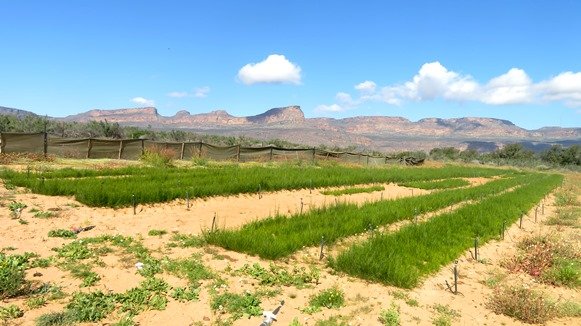Aspalathus linearis seedling production

Author: Ivan Lätti
Photographer: Thabo Maphisa
Aspalathus linearis seedlings are nurtured here under irrigation for months before transplanting into prepared fields, spaced for each plant to become the perennial shrub from which repeated harvesting is done. On some farms much of the work is still done by hand, mechanisation adopted in bigger, modern operations.
Some start the process in midsummer with germinating the seeds, transplanting seedlings at the beginning of winter, while these beds were photographed at the end of winter near Vanrhynsdorp. Soil preparation may involve ripping the soil without overturning it for optimising growth conditions for the spreading roots. Watering and nutrient addition depending on soil needs of the particular field are increasingly following scientifically evolved methodology.
Annual harvesting around the end of summer has for long been done using sickles and transporting the bundled branches to “tea courts” for processing. The cutting is done about 10 cm from the ground, allowing the pruned plants to regrow for another cutting in a year’s time.
Then follow sorting, cutting the material into tiny pieces of a few millimetres and “sweating” the fresh green product under controlled conditions of managing moisture. Enzymatic oxidation occurring during this fermentation turns the small green plant pieces red, the appearance that makes it rooibos (red bush). The desired aromatic qualities of the prepared product are implicit in the marketing based on colour.
A short period of sun drying in the tea court follows. To achieve this, the fermented heaps are now spread thinly for a day or two, then all is collected again into bulk containers. To produce “green rooibos”, an alternative product, the fermentation phase is skipped, drying following straight after cutting.
Sieving is now done for removing impurities, followed by steam sterilisation, pasteurisation and final drying. Testing and grading form part of quality control before packaging.
Tools, machinery and practices involved in rooibos production have been evolving through many stages and styles as science, commerce and customer needs dictated. On some farms the naturally grown product is still collected from the mountains involving manual processes very much like early users obtained their tea before plantations.
Before that Bushmen hunter gatherers would merely grab a handful of leaves in passing and chew them. This was done for taste and possibly health reasons as articulated in their culture; certainly very different from those formulated by todays laboratory specialists (http://jamaka.co.za; www.klipopmekaar.co.za; www.rooibos-route.co.za).

